
Key takeaways
Australia’s property markets have remained resilient in the first half of 2025, supported by economic stability and strong fundamentals like low unemployment and ongoing housing shortages.
This week ANZ Bank has upgraded their forecasts for the Australian property markets for the next two years.
They now expect capital city prices to rise 5.0% in 2025 and 5.8% in 2026.
ANZ see 3 factors which are likely to drive Australia’s housing market performance: rate cuts, supply and affordability.
This week, Cotality also reports that:
*Sydney property prices increased 0.2% over the last week, increased 0.7% over the last month and are 1.8% higher than they were 12 months ago.
*Melbourne property prices increased 0.1% over the last week, increased 0.4% over the last month, and increased 0.8% compared to 12 months ago.
*Brisbane property prices increased 0.1% over the last week, increased 0.6% over the last month and are 7.2% higher than they were 12 months ago.
Overall, Australian capital dwelling prices increased 0.6% over the last month and are now 3.1% higher than they were 12 months ago.
There were 1,584 homes were taken to auction last week.
The combined capital’s preliminary clearance rate coming in at 71.7% last week, down from 72.3% the previous week.
This current property cycle has been driven by an undersupply of good properties relative to current demand pushing up property values and rents there was nothing to suggest there will be any significant change in the near future.
Unfortunately, the undersupply properties is going to persist for some time with all commentators agreeing that there is no way we're going to hit the housing construction targets required to meet our demand.
This week ANZ Bank has upgraded their forecasts for the Australian property markets for the next two years.
They now expect capital city prices to rise 5.0% in 2025 and 5.8% in 2026.
ANZ see 3 factors which are likely to drive Australia’s housing market performance: rate cuts, supply and affordability.
However, as always, our markets will be fragmented.
Source: ANZ Bank
On the auction front this week... 1,584 homes were taken to auction
The combined capital’s preliminary clearance rate coming in at 71.7% last week, down from 72.3% the previous week.
This week, Cotality also reports that:
- Sydney property prices increased 0.2% over the last week, increased 0.7% over the last month and are 1.8% higher than they were 12 months ago.
- Melbourne property prices increased 0.1% over the last week, increased 0.4% over the last month, and increased 0.8% compared to 12 months ago.
- Brisbane property prices increased 0.1% over the last week, increased 0.6% over the last month and are 7.2% higher than they were 12 months ago.
Overall, Australian capital dwelling prices increased 0.6% over the last month and are now 3.1% higher than they were 12 months ago.
Clearly, the property cycle is moving on but our markets are very fragmented.

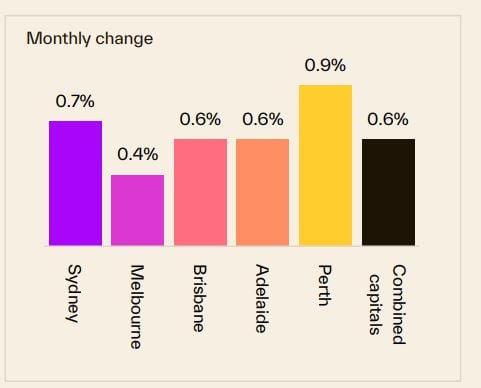
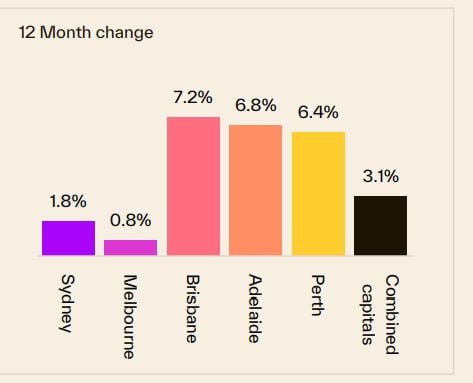
Source: Cotality August 11th 2025
Of course, these are "overall" figures - there is not one Sydney or Melbourne or Brisbane property market.
And various segments of each market are performing differently.
At the beginning of this cycle the upper quartile of the market lead the upswing but last year the lower quartile across every capital city recorded a stronger outcome for housing values relative to its upper quartile counterpart.
The following chart shows how various segments of each capital city market are performing differently with median-priced properties performing well.

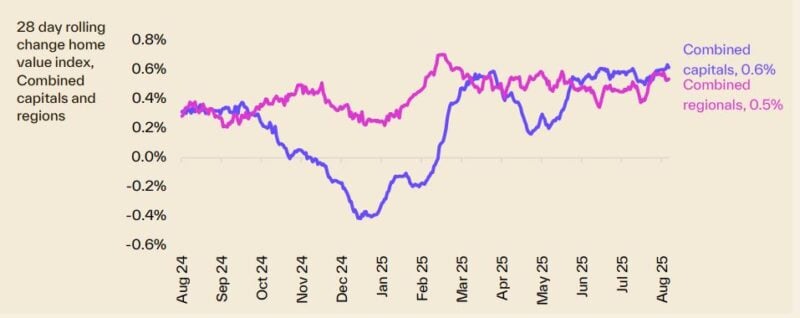
To help keep you up-to-date with all that's happening in property, here is my updated weekly analysis of data and charts as of 11th August 2025 provided by SQM Research, Cotality, and realestate.com.au.
Current property asking prices
Property asking prices are a useful leading indicator for housing markets - giving a good indication of what's ahead.
Here is the latest data available:
Sydney
| Property type | Price ($) | Weekly Change | Monthly Change % | Annual % change |
|---|---|---|---|---|
| All Houses | 2,037,624 | -1.329 | 0.1% | 6.3% |
| All Units | 869,737 | 2.262 | 2.3% | 6.1% |
| Combined | 1,561,861 | -0.182 | 0.6% | 6.0% |
Source: SQM Research
Melbourne
| Property type | Price ($) | Weekly Change | Monthly Change % | Annual % change |
|---|---|---|---|---|
| All Houses | 1,296,632 | 1.668 | -0.6% | 4.8% |
| All Units | 631,132 | 1.268 | 0.3% | 3.1% |
| Combined | 1,086,259 | 1.427 | -0.4% | 4.3% |
Source: SQM Research
Brisbane
| Property type | Price ($) | Weekly Change | Monthly Change % | Annual % change |
|---|---|---|---|---|
| All Houses | 1,259,583 | 0.200 | 0.5% | 11.2% |
| All Units | 743,506 | 5.584 | 1.5% | 16.4% |
| Combined | 1,129,746 | 1.478 | 0.7% | 11.9% |
Source: SQM Research
Perth
| Property type | Price ($) | Weekly Change | Monthly Change % | Annual % change |
|---|---|---|---|---|
| All Houses | 1,156,501 | 10.850 | 0.5% | 11.9% |
| All Units | 654,228 | -1.482 | 1.6% | 18.2% |
| Combined | 1,024,865 | 7.569 | 0.7% | 12.8% |
Source: SQM Research
Adelaide
| Property type | Price ($) | Weekly Change | Monthly Change % | Annual % change |
|---|---|---|---|---|
| All Houses | 1,048,942 | 2.745 | -1.2% | 13.2% |
| All Units | 562,961 | -1.031 | 0.4% | 22.0% |
| Combined | 961,498 | 2.037 | -1.0% | 14.0% |
Source: SQM Research
Canberra
| Property type | Price ($) | Weekly Change | Monthly Change % | Annual % change |
|---|---|---|---|---|
| All Houses | 1,226,001 | 9.236 | 1.2% | 1.6% |
| All Units | 589,594 | -3.470 | -1.2% | 0.4% |
| Combined | 987,949 | 4.026 | 0.7% | 0.8% |
Source: SQM Research
Darwin
| Property type | Price ($) | Weekly Change | Monthly Change % | Annual % change |
|---|---|---|---|---|
| All Houses | 797,721 | -4.321 | 2.6% | 21.6% |
| All Units | 432,340 | 9.910 | 4.4% | 13.8% |
| Combined | 654,098 | 1.247 | 3.1% | 19.4% |
Source: SQM Research
Hobart
| Property type | Price ($) | Weekly Change | Monthly Change % | Annual % change |
|---|---|---|---|---|
| All Houses | 840,398 | -4.398 | -0.2% | 7.1% |
| All Units | 495,580 | -0.780 | -0.4% | -2.2% |
| Combined | 791,717 | 1.596 | 0.1% | 6.7% |
Source: SQM Research
National
| Property type | Price ($) | Weekly Change | Monthly Change % | Annual % change |
|---|---|---|---|---|
| All Houses | 1,008,727 | 11.388 | 0.1% | 8.2% |
| All Units | 592,803 | 2.231 | 1.4% | 6.9% |
| Combined | 918,674 | 9.342 | 0.3% | 7.9% |
Source: SQM Research
Cap City Average
| Property type | Price ($) | Weekly Change | Monthly Change % | Annual % change |
|---|---|---|---|---|
| All Houses | 1,482,013 | 12.438 | 0.6% | 7.4% |
| All Units | 746,794 | 0.460 | 1.5% | 7.9% |
| Combined | 1,262,803 | 8.697 | 0.7% | 7.3% |
Source: SQM Research
The value of property asking prices as a leading indicator for housing markets is quite significant.
In fact it's more valuable than median prices which can be quite misleading.
Let's delve into why this is the case and how it impacts the real estate market.
- Early Market Sentiment Indicator: Asking prices often reflect the current sentiment of sellers in the real estate market.
If sellers are confident, they might set higher asking prices, anticipating strong demand.
Conversely, if sellers are uncertain or perceive a market downturn, they might lower their asking prices to attract buyers.
This makes asking prices a real-time indicator of market sentiment, often preceding changes in actual sales prices. - Predictive of Future Price Trends: Trends in asking prices can be predictive of where the actual property prices are headed.
For example, a consistent rise in asking prices over a period can signal an upcoming rise in transaction prices. - Impact of Economic Factors: Economic factors such as interest rates, employment rates, and broader economic health influence asking prices.
For instance, changes in the Reserve Bank of Australia's policies or shifts in the job market can quickly reflect in the asking prices, providing insights into how these factors are influencing the housing market. - Regional Variations: In a diverse market like Australia's, asking prices can also provide insights into regional disparities.
For instance, the property markets in Melbourne and Sydney might behave differently from those in Brisbane or Perth. Asking prices can give early indications of these regional trends. - Influence of Supply and Demand: Asking prices are also a response to the balance of supply and demand in the market.
In areas with limited supply and high demand, asking prices tend to be higher and vice versa.
However, it's important to note that while asking prices are a valuable indicator, they should not be used in isolation.
Other factors like actual sales prices, time on the market, auction clearance rates, and economic conditions also play crucial roles in understanding the property market dynamics.
READ MORE: The latest median property prices in Australia’s major cities
Last weekend's auction report
Preliminary clearance rates lose a ‘little’ steam
Across Australia’s capital cities, 1,584 homes were taken to auction last week, roughly in line with the number seen the week prior (+0.6%) but 16.2% lower relative to the same week a year ago (1,891).
After reaching a 12-month high at the end of July (74.7%), auction markets have lost a little steam in the first two weeks of August, with the combined capital’s preliminary clearance rate coming in at 71.7% last week, down from 72.3% the previous week.
Despite the lower result, the preliminary capital city clearance rate has held above the 70% mark for nine weeks running, reflecting a solid improvement in selling conditions as we lead into spring.
With another rate cut almost a certainty on Tuesday, it will be interesting to see if early clearance rates bounce higher this week.
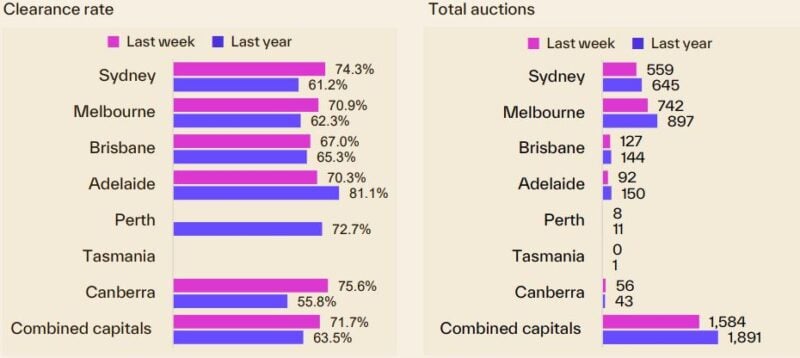
Melbourne hosted 742 auctions last week, up from 730 the week prior.
While last week's result of 70.9% marked Melbourne's fifteenth consecutive week with a preliminary clearance rate above the 70% mark, it was also the city's lowest early result in four weeks.
559 auctions were held in Sydney last week, down 2.1% from the 571 held the previous week.
74.3% of the 443 auction results reported so far were successful.
Although down from 74.9% the previous week, last week was Sydney’s ninth consecutive week with an early clearance rate above 70%.
Brisbane led the volume of auctions across the smaller markets, with 127 homes taken to auction, in line with the week prior (128).
67.0% of homes have so far been reported as sold, marking the city’s lowest preliminary clearance rate in four weeks.
92 homes went to auction in Adelaide, with 70.3% returning a positive result, the highest in three weeks.
The ACT saw 56 homes auctioned last week and reported an early clearance rate of 75.6%, which was the capital's highest result since June 2024 (76.5%).
Eight auctions were held in Perth last week, with one of the five results collected so far reporting a positive result.
There have been no auctions in Tasmania for the past three weeks.
The volume of auctions is set to rise in the coming weeks, with approximately 1,940 homes scheduled for auction this week, and just over 2,000 set for auction the week after.
Our rental markets
According to Cotality, with rental vacancy rates holding close to historic lows,tracking at 1.7% nationally in July, there has been some evidence of reaccelerating growth trends.
On a seasonally adjusted basis, national rents were up 1.1% over the three months ending July, up from a recent low of 0.5% through the September quarter last year.
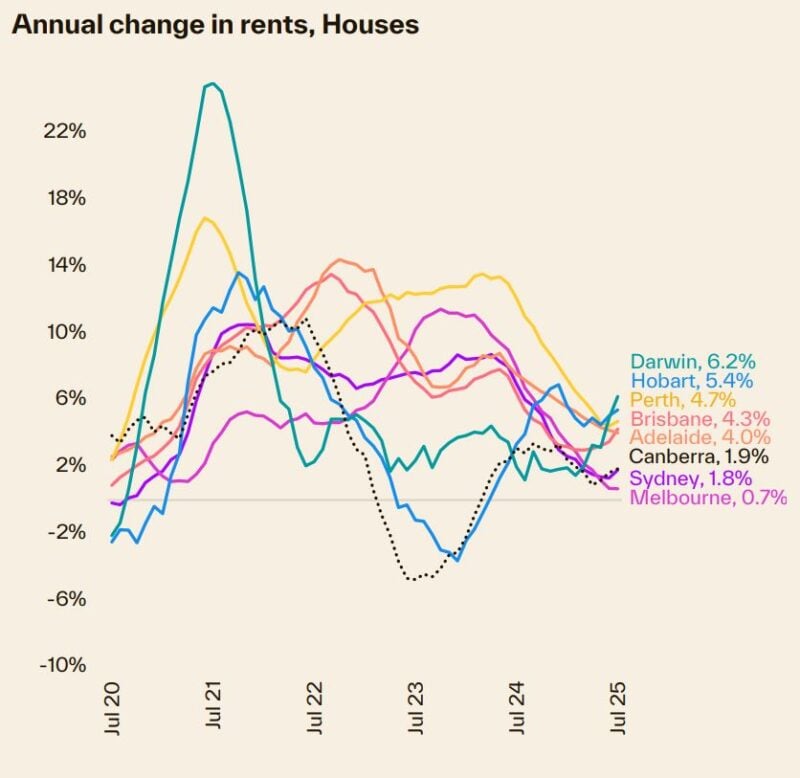
The unit sector has seen a stronger trend with seasonally adjusted rents up 1.3% over the past three months after dipping to a rolling quarterly change of just 0.5% through the end of last year.
However, growth in house rents has also picked up, rising to 1.1% after the three-month trend eased back to just 0.5% in Q3 last year.
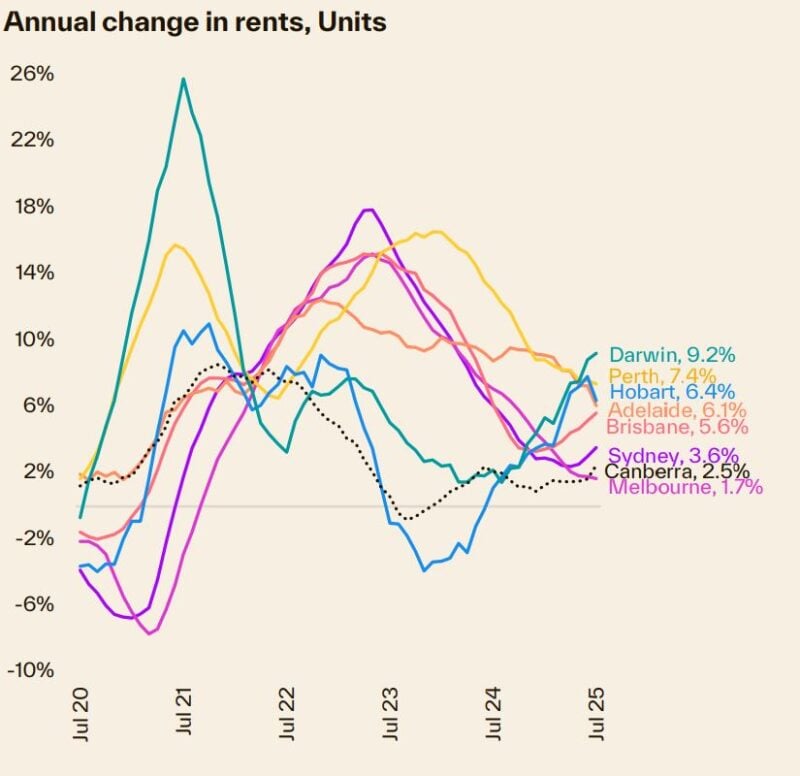
Although rental growth has picked up, gross rental yields edged lower in July, reducing to 3.68% nationally across all dwellings, down from 3.71% in April.
The highest capital city gross rental yields, by far, can be found in Darwin at 6.4%, a factor of relatively low purchase prices relative to rental income.

Sydney
| Property Type | Rent ($) | Weekly change | Monthly change | 12 Months change |
|---|---|---|---|---|
| All Houses | $1,076.82 | 4.18 | 0.4% | 4.5% |
| All Units | $710.46 | 2.54 | 1.1% | 2.3% |
| Combined | $859.03 | 3.19 | 0.7% | 3.3% |
Source: SQM Research
Melbourne
| Property Type | Rent ($) | Weekly change | Monthly change | 12 Months change |
|---|---|---|---|---|
| All Houses | $767.94 | 1.06 | 0.4% | 4.1% |
| All Units | $573.78 | 0.22 | -0.5% | 3.0% |
| Combined | $654.68 | 0.65 | 0.0% | 3.6% |
Source: SQM Research
Brisbane
| Property Type | Rent ($) | Weekly change | Monthly change | 12 Months change |
|---|---|---|---|---|
| All Houses | $770.59 | 4.41 | 1.2% | 5.0% |
| All Units | $607.92 | 0.08 | 1.0% | 6.2% |
| Combined | $697.36 | 2.47 | 1.1% | 5.5% |
Source: SQM Research
Perth
| Property Type | Rent ($) | Weekly change | Monthly change | 12 Months change |
|---|---|---|---|---|
| All Houses | $830.13 | -8.13 | 0.6% | 6.1% |
| All Units | $653.28 | -2.28 | -0.6% | 5.1% |
| Combined | $756.87 | -5.67 | 0.2% | 5.8% |
Source: SQM Research
Adelaide
| Property Type | Rent $) | Weekly change | Monthly change | 12 Months change |
|---|---|---|---|---|
| All Houses | $671.13 | 1.87 | -0.1% | 2.5% |
| All Units | $521.50 | 0.50 | -0.7% | 5.3% |
| Combined | $620.38 | 1.45 | -0.3% | 3.3% |
Source: SQM Research
Canberra
| Property Type | Rent ($) | Weekly change | Monthly change | 12 Months change |
|---|---|---|---|---|
| All Houses | $777.75 | 3.25 | -0.5% | 0.0% |
| All Units | $585.02 | -3.02 | 0.5% | 4.8% |
| Combined | $672.37 | -0.22 | -0.1% | 2.1% |
Source: SQM Research
Darwin
| Property Type | Rent ($) | Weekly change | Monthly change | 12 Months change |
|---|---|---|---|---|
| All Houses | $785.06 | 4.94 | 4.7% | 16.9% |
| All Units | $560.25 | 6.75 | 1.5% | 5.5% |
| Combined | $652.05 | 6.07 | 3.0% | 10.9% |
Source: SQM Research
Hobart
| Property Type | Rent 9$) | Weekly change | Monthly change | 12 Months change |
|---|---|---|---|---|
| All Houses | $584.62 | 12.38 | 1.9% | 8.9% |
| All Units | $503.65 | 3.35 | 2.3% | 8.5% |
| Combined | $552.29 | 8.79 | 2.0% | 8.8% |
Source: SQM Research
National
| Property Type | Rent ($) | Weekly change | Monthly change | 12 Months change |
|---|---|---|---|---|
| All Houses | $722.00 | 5.00 | -0.3% | 3.9% |
| All Units | $569.00 | 4.00 | 1.2% | 4.6% |
| Combined | $651.06 | 4.55 | 0.3% | 4.2% |
Source: SQM Research
Cap City Average
| Property Type | Rent ($) | Weekly change | Monthly change | 12 Months change |
|---|---|---|---|---|
| All Houses | $868.00 | 3.00 | 0.6% | 4.8% |
| All Units | $644.00 | 1.00 | 0.6% | 3.7% |
| Combined | $748.89 | 1.96 | 0.6% | 4.3% |
Source: SQM Research
Sellers of good properties are on strike
After rebounding somewhat in May, the flow of new listings eased through June, with just 33,159 new properties advertised for sale nationally over the four weeks to June 29th.
Down -11.7% compared to this time last year and -9.2% below the fiveyear average, the current flow of freshly listed stock is the lowest observed for this time of year since 2020.
The shortfall in new listings, coupled with a strong absorption rate has seen total listings drift lower.
At the national level, Cotality observed 127,020 for sale listings over the four weeks to June 29th, down -11.8% from the recent March high (144,025), and -16.7% below this time of year’s five-year historic average.
Vendor metrics
As the following chart shows, it's taking longer to sell a home.

Nationally, properties are taking longer to sell with the median time on market rising to 35 days in the June quarter, up from 34 days over the March quarter and 29 days in Q2 2024.
Over the year, Brisbane (25 days) recorded the largest increase in selling times across the capitals, up 9 days, followed by Hobart (49 days), which saw an 8-day increase.
Darwin (43 days) and Canberra (53 days) were the only capitals to see the median time on market decline over the year, with selling times falling by 12 and 3 days, respectively.
















